Battle of Sarikamish - Picture
More about World War 1
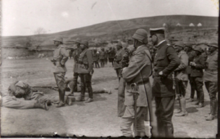
|
|
Battle of Sarikamish
Date
December 22, 1914 - January 17, 1915
Location
Sarikamish (then in Russian Armenia)
Result
Russian victory
Date: December 22, 1914 - January 17, 1915
Location: Sarikamish (then in Russian Armenia)
Result: Russian victory
Belligerents:
: Russian Empire
Commanders and leaders:
: Aleksandr Myshlayevsky
Nikolai Yudenich
Arshak Gafavian
Strength:
: Russian Caucasus Army
100,000
Casualties and losses:
: ~30,000(KIA:16,000, sick 12,000)
The Battle of Sarikamish was an engagement between the Russian and Ottoman empires during World War I. It took place from December 22, 1914 to January 17, 1915 as part of the Caucasus Campaign. The outcome was a Russian victory. The Ottomans employed a strategy which demanded that their troops be highly mobile and to arrive at specified objectives at precise times. This approach was based both on German and Napoleonic tactics. The Ottoman troops, ill-prepared for winter conditions, suffered major casualties at the Allahx¼ekber mountains.
Background
Russia viewed the Caucasus front as secondary to the Eastern Front and the Eastern Front enjoyed the major share of Russian resources. Russia had taken the fortress of Kars, Turkey from the Turks during the Russo-Turkish War in 1877 and feared a Caucasus Campaign aimed at retaking Kars and the port of Batum.
The Ottoman generalship and organization were negligible compared to the Russians. A Caucasus Campaign would have a distracting effect on Russian forces. The plan found sympathy with German advisors in that a success in this region would mean a diversion of Russian forces to this front from the Polish and Galician fronts. Germany supplied resources and the Ottoman 3rd Army was used in the battle. The immediate strategic goal of the Caucasus Campaign was to retake Artvin, Ardahan, Kars, and the port of Batum. As a longer term goal, head of the Ottoman war ministry Ä°smail Enver hoped a success would facilitate opening the route to Tbilisi and beyond, with a revolt of Caucasian Muslims. Another Turkish-or rather German-strategic goal was to cut Russian access to its hydrocarbon resources around the Caspian Sea. The Anglo-Persian Oil Company had exclusive rights to work petroleum deposits throughout the Persian Empire except in the provinces of Azerbaijan, Ghilan, Mazendaran, Asdrabad and Khorasan. In 1914, before the war, the British government had contracts with the company for the supply of fuel oil for the navy.
Prelude

Picture - Ismail Enver and Otto von Feldmann inspecting the units
The headquarters of the 3rd Army was located in Erzurum under the command of Hasan Izzet. On October 30, 1914, the 3rd Army headquarters was informed by High Command in Istanbul about an exchange of fire during the pursuit of Goeben and Breslau in the Black Sea. High Command expected the Russian Army to cross the Ottoman border at any time. The Bergmann Offensive (November 2, 1914 - November 16, 1914) ended with the defeat of Russian troops under Bergmann. The Russian success was along the southern shoulders of the line. Hasan İzzet stabilized the front by letting the Russians 25 kilometres (16 mi) inside the Ottoman Empire along the Erzurum-SarıkamıŠaxis.
The war minister, Ä°smail Enver, devised an operation plan while he was at the Department of War in Istanbul. His strategy was based on German principles copied from Napoleon. Enver's plan involved a single envelopment using three Corps. On the right flank, XI Corps would fix the Russians in place and conduct feint attacks. In the center, IX Corps would fight in the direction of SarıkamıŠPass. Assistant Chief of Staff Colonel Hafız Hakkıâs X Corps, which was to be on the left flank, would drive to Oltu, cross the Allahx¼ekber Mountains, cut the Kars road, and drive the Russians to the Aras Valley, where the Russian forces would be destroyed by all three Corps attacking in concert. Meanwhile a detachment unit under Stange Bey would conduct highly visible operations to distract and pin Russian units. Success depended on all troops arriving at their specified objectives at the correct moment. The first part of the plan was fulfilled when the Russians concentrated their forces at SarıkamıŠand Kx¶prx¼kx¶y after the Bergmann Offensive.
Hasan İzzet was not in favor of an offensive action in the harsh winter conditions. He was planning to remain in a defensive posture by pulling the Russians to Erzurum Fortress and launching a counter attack. Hafız Hakkı was sent to replace the commander of X Corps to energize the 3rd Army. Enver released Hasan İzzet from command on December 14. İzzet told Enver:
We have to consider 8 or 9 days for a large scaled encircling manoeuvre. However, during this time the XI Corps, which will remain at the front, might be jeopardized. Even if we execute the manoeuvre with two corps, they will probably face difficulties against the enemy.
We have to consider 8 or 9 days for a large scaled encircling manoeuvre. However, during this time the XI Corps, which will remain at the front, might be jeopardized. Even if we execute the manoeuvre with two corps, they will probably face difficulties against the enemy.
Enver wanted his plan executed through a winter offense, and decided to take charge. He left Istanbul with General Fritz Bronsart von Schellendorf and the head of the Operations Office Lieutenant Colonel Otto von Feldmann. They arrived in Erzurum on December 21. Senior Turkish commanders opposed the forced resignation of Hasan Ä°zzet due to his rejection of the plan.
Battle
Battlefield
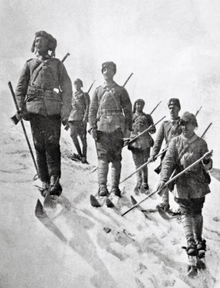
Picture - Ottoman 3rd Army winter gear
The war zone was nearly 1,250-1,500 kilometers (776-932 miles) wide from the Black Sea to Lake Van, which made military concentration difficult. The operation was executed at a plateau averaging 1,500-2,000 meters (5,000-6,500 feet) above sea level. The main difficulty with the region was the roads, with the transportation infrastructure on the Ottoman side far from adequate. Russia's main advantage was the Kars Gyumri Akhalkalaki railway line and a terminal at SarıkamıÅ. The railway was 24 kilometres (15 mi) from the border. The only way for an army to get through the Caucasian heights was the high mountain passes in which lay the cities Kars and SarıkamıÅ. Beyond, the upper valleys of the Aras River and Euphrates extended westward. Everywhere else the roads were mere tracks which were impenetrable to artillery. The forces were concentrated about 80 kilometres (50 mi) on each side of the border at the fortresses of Kars on the Russian side and Erzurum on the Ottoman side.
The 3rd Army, under the command of Enver, was composed of the IX, X and XI Corps. 3rd Army's headquarters and the IX Corps were located in Erzurum. The X Corps was stationed in Sivas, and the XI Corps was in ElazÄ±Ä (Mamuretx¼laziz). A detachment unit under the command of the German Lieutenant Colonel Stange was established from the 3rd Infantry Division, originally stationed in Thrace, to reinforce the offense and pin down the Russians. This detachment unit, known as Stanke Bey, consisted of two battalions of the 8th Infantry Regiment and two artillery batteries. The fighting power of 83,000 regular troops, reserves, and personnel from the Erzurum Fortress totalled 118,000. The total manpower including transportation units, depot regiments, and military police was 150,000. There were 73 machine guns and 218 artillery pieces. Ottoman forces were inadequately prepared for the campaign. Two divisions of the IX Corps began a long trek with no winter clothing and only dry bread and olives for rations.
The Russian Caucasus Army was a well-equipped 100,000 troops. However, the Russians redeployed almost half of the Caucasus Army to the Prussian front due to the defeats at the Battle of Tannenberg (August 23-September 2, 1914) and the Masurian Lakes (September 9-14, 1914), leaving behind 65,000 troops. To remedy these troop movements Count Illarion Ivanovich Vorontsov-Dashkov consulted with the Mayor of Tbilisi Alexandre Khatsian, the primate of Tbilisi Bishop Mesrop, and the prominent civic leader Dr. Hakob Zavriev about the creation of Armenian volunteer detachments. The Russian Armenian reservists had already been drafted into the regular armed forces and sent to the European theatre. The volunteer units consisted of Armenians, who were not citizens of the empire or obligated to serve. Originally, there were four volunteer battalions created. Along the Kars Oblast, the 3rd battalion commanded by Hamazasp (Srvandztian) and 4th battalion by Keri (Arshak Gavafian) operated on the front facing Erzurum between SarıkamıŠand Oltu. The Commander-in-Chief of the Caucasian Military District (Caucasian Army) was Illarion Ivanovich Vorontsov-Dashkov. Effective command was in the hands of Infantry General Aleksandr Zakharevich Myshlayevsky, who was originally a military historian graduated from the Imperial General Staff Academy. General Nikolai Yudenich was his Chief of Staff.
Initial manoeuvres, December 22-28
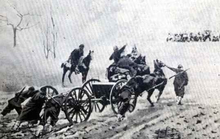
Picture - Soldiers push an artillery piece up the mountain passes
Hafız Hakki was at the left flank. His order was to move the IX and X Corps to SarıkamıŠand Kars. He contemplated a two step plan: a sudden initial attack and a second step with both Corps proceeding at full speed towards Oltu. He expected the assault at Narman to be concluded by the afternoon of December 22. Then the Corps would march 30 kilometers a day and arrive in the Kars-SarıkamıŠline by December 25. Two divisions of the Stange regiment had been sent by sea from Constantinople to Trabzon.
On early December 22, Hafız Hakkı ordered his troops to move forward. They engaged in a brief skirmish against a Russian brigade commanded by General Istomin near KaleboÄazı, west of Oltu. The skirmishes at KaleboÄazı ended the next day with the Ottomans capturing four artillery guns, four machine guns, and 1,000 Russian troops.
On December 23, Istomin abandoned his position and moved towards Ardahan. Hafız Hakkı sent two divisions to pursue Istomin. At the extreme left wing, the Stange Regiment, which had landed at Trabzon, was to move up the xoruh valley towards Ardahan and through a pass at 2,438 metres (7,999 ft) altitude.
On December 23, the 92nd Regiment of the 31st Division, believing the unit in front of them to be Russians, opened fire on the flank of the 32nd Division. The ensuing four hour fight in the fog killed 2,000 Turkish soldiers.
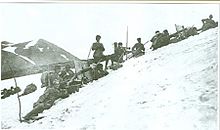
Picture - Machine gun unit at Allahx¼ekber Mountains
On December 24, Hafız Hakkı was well beyond Oltu after having marched 75 kilometres (47 mi) in just over three days. However, they were not at the Kars-SarıkamıŠline as planned.
On December 25, Ottoman troops had been marching for 14 hours under heavy snow. The soldiers were exhausted and hungry; the fear of frostbite and Russian machine guns was slowly being replaced by absolute indifference.
In the early hours of December 26, at the 18th hour of the march, the 91st Regiment of X Corps came under enemy fire. The Russians left the scene after nearly two hours of fighting. The regiment resumed its march, and soon a snow storm began. Under these conditions the 91st Regiment managed to reach Kosor from Penek (a distance of just 8 km) in 21 hours. Other units reached their destinations at a similar rate. While Enver was ordering a night attack, elements of the X Corps were spending the night in the villages of Kosor, Arsenik, and Patsik, which were 40, 35 and 30 kilometers from SarıkamıŠrespectively. The Allahx¼ekber Mountains were still to be crossed. Thousands of Turkish soldiers died of hypothermia in the snow.
![World War 1 Picture - 4th battalion of the Armenian volunteers engaged at Barduz Pass.[13]](./images/1-images52211/220px-Pervaya_Armyanskaya_Drujina_4_battalion_1914.png)
Picture - 4th battalion of the Armenian volunteers engaged at Barduz Pass.[13]
The X Corps suffered a delay of 24 hours in the Barduz Pass, and 4th battalion of the Armenian volunteers lost 600 troops in a battle there.
When commander Malyshevsky arrived at army headquarters in the Russian front lines, he gave the order for a general retreat. The process of withdrawing was to start on December 25 and 26. The Russians evacuated SarıkamıÅ, leaving two cavalry squadrons and 1,000 railwaymen to defend it. Not all Russian commanders were in a state of panic. The Russian army headquarters maintained a solid grip on the situation, with the effective command and control never lost. General Yudenich, taking command of the II Turkestan Corps, decided to put up resistance.
On December 28, the Russians held by the XI Corps at Horasan. The IX Corps were at SarıkamıÅ. The X Corps were threatening to pierce the Russian front along the Kars railway to the east. The Stange regiment was descending upon Ardahan 60 miles to the northeast. Enver's operational plan was looking successful on paper.
However, the Ottoman forces were worn out, half starved, and short of guns and ammunition. They had no hope of reaching their objective on time. Enver thought that the Russians were retreating to Kars. It was actually an encircling movement.
Assault at SarıkamıÅ, December 29
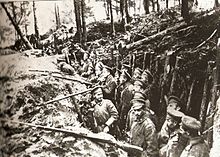
Picture - Russian trenches in the forests of SarıkamıÅ
On December 29, the assault took place. The IX and XI Corps, totaling 12,000 men, began to attack SarıkamıÅ. During bayonet fighting, only 300 men succeeded in breaking into the city. They were driven off, losing 6,000 troops. Enver received information that Russians were preparing to encircle his forces with a force of five regiments.
On December 31, the IX Corps was bogged down in the woods outside SarıkamıŠand had been reduced to some 2,500 men and 14 artillery guns and machine guns. On the same night news arrived to headquarters from Bardız: The 32nd Division had abandoned its positions to the Russians. This meant that the Barduz and Kızılkilise roads were now in Russian hands. The Ottoman forces were inside a semicircle. Enver refused to lose momentum, and ordered his units to continue with the plan.
On January 1, the commander of the XI Corps pressed a frontal attack on SarıkamıŠthat lasted for the next four days; after that the fighting began to lose momentum. Snow hindered advancing forces which were supposed to bring relief. The IX Corps melted away on the way to SarıkamıÅ. One of the divisions lost 40% of its strength in a snowstorm. The X Corps never came to the rescue. 90% of X Corps was left on the slopes of the Allahx¼ekber Mountains. The XI Corps was fighting in the Aras region. A regiment entered xerkezkx¶y, only to be taken prisoner. While the Stange regiment entered Ardahan on schedule, the troops were exhausted. The Russians were poised to encircle the remaining forces.
Entrapped in a semicircle, January 2-3
On January 2, Russian artillery fire caused severe casualties. Enver received two reports; one was from the chief of staff of the IX Corps, Lieutenant Colonel Åerif, and the other from Colonel Hafız Hakkı. Both reports said that they were too weak to launch another attack. Enver responded to the units: "The offensive is to go on at full strength." Later Enver focused on securing routes for the retreat instead of insisting on new attacks to take SarıkamıÅ. He combined the two corps and renamed it the "Left Wing Army." He promoted Colonel Hafız Hakkı to Brigadier General and gave him command of the Left wing Army.
On January 3, I Corps were driven out to the Choruk Valley, in which direction the remnants of the X Corps were also retreating. Hafız Hakkı was hoping for reinforcements. He did not order his units to retreat as he believed it could be still possible to take SarıkamıÅ. Meanwhile, around 40 km south, the XI Corps led by Galip was renewing attacks on Russian lines in an attempt to relieve the pressure on the IX and X Corps positioned in front of SarıkamıÅ. The Russians were advancing and the circle was getting narrower.
On January 4, Hafız Hakkı toured the front line. He told Ä°hsan that the battle was over unless some of the troops on the Allahx¼ekber Mountains were still alive.
Retreat, January 4-15
On January 6, the 3rd Army headquarters found itself under fire. The Russians captured the entire 28th Division. The 17th and 29th Divisions were taken prisoner. Eight senior officers including Ä°hsan surrendered to the Russians. Among the captives, 108 officers and 80 soldiers transferred to SarıkamıÅ. Hafız Hakkı managed to safely reached the headquarters of the X Corps. He was told that the IX Corps had fallen into the hands of Russians and ordered a total retreat. On January 7, the remaining forces began their march towards Erzurum.
On January 11, after four days of travel, Enver and the German officers reached Erzurum. They had stipulated in their original plan that the same route could be taken by the advancing 3rd Army in two days. The transports dispatched from Constantinople which attempted to land troops and provisions at Trabzon were sunk by a Russian Black Sea squadron and warships. The escorts SMS Goeben and TCG Hamidieh were chased back to the Bosporus.
On January 17, the remnants of the Ottoman forces in the woods outside SarıkamıŠwere collected, which signaled the end of fighting on this front. The Russian right wing cleared the Choruk Valley. Enver's project ended in failure after three weeks of struggle amid high mountains and deep snowdrifts. For a time, at least, Russia was secure from attack in the Caucasus. Hafız Hakkı expected that the Russians would use this success to capture the Erzurum Fortress. The 3rd Army immediately tried to take measures, but this proved to be nearly impossible as all the local reserves were depleted.
On February 12, Hafız Hakkı died of typhus at the age of 36. Otto Liman von Sanders, who had been asked before, rejected the position again. Mahmut Kamil took the command of the Army. War minister Enver never commanded troops in battle again.
Casualties
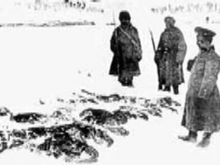
Picture - Russians collecting the frozen bodies of Turkish soldiers
The Ottoman 3rd Army started with 118,000 fighting men. It was reduced to 42,000 effective soldiers in January 1915. There are conflicting figures for Ottoman casualties. Sources do not agree on what sould be included in the final sum. The Turkish official history states 32,000 KIA, 15,000 died of sickness, 7,000 prisoners, 10,000 wounded, for some 50,000 total casualties. The casualties of the conflict escalated beyond the end of the active warfare period as the most immediate problem confronting the 3rd Army became the typhus epidemic. TAF presents a figure of 60,000 casualties throughout the period of the operation. Russians took 7,000 POWs including 200 officers. These prisoners were kept under confinement for the next three years in the small town of Varnavino east of Moscow on the Vetluga River. After the final days of the Czarist empire, these soldiers had a chance to return to the ailing Ottoman Empire.
Russian losses were 16,000 killed in action and 12,000 died of sickness, mostly due to frostbite. TAF sources report around 30,000 fatalities without giving details on the breakdown of this number.
Assessment
Nikolai Yudenich
Hafız Hakkı
Ismail Enver
Operation
Enver was the strategist of the operation. Hassan Izzet was the tactician who implemented the plan and remedied the shortcomings. The failure was blamed on Enver. Beyond his faulty estimate on how the enveloped Russians would react, his failure was on not keeping adequate operational reserves. He did not have enough field services to alleviate the hardships faced by the soldiers; he analyzed operational necessities theoretically rather than contextually.
Carrying out a military plan in winter was not the major failure of the operation. A valid question is whether or not the plan could have been executed better. It would be hard to exceed the performance of the Turkish soldiers. The IX and X Corps marched with maximum effectiveness given the conditions. The majority of the units managed to move to the correct positions. In respect to the inflicted Russian casualties, they should be credited.
The communication and cooperation between the Ottoman units failed; forces functioned as separate units rather than in mutually supporting engagements as originally planned. There was not a sufficient operational reserve established for the size of engagement. The conditions for the Ottoman forces could have been better, if Enver paused the operations on December 24, and had not moved beyond the Oltu line with the artillery pieces. The decision to take the heavy artillery rather than short range smaller caliber guns beyond the Oltu line was a failure, as the forces faced detachment units with better mobility. The plan had a faulty estimate of the size of the Russian forces. The commanders of the X and IX Corps were replaced with men of little or no experience at the operational level. The chief of staff of IX Corps Kx¶prx¼lx¼lx¼ Åerif Bey said, "..troops fought on the top of tall mountains under snowstorm against the artillery of an enemy of centuries and they were completely annihilated, but not a single Turkish soldier has ever turned his back to his nation... In Sarikamish, there was no panic.â
Light infantry
![World War 1 Picture - 3rd battalion and cavalry unit commanded by Hamazasp (Srvandztian)[11]](./images/1-images52211/220px-Pervaya_Armyanskaya_Drujina_3_battalion_1914.png)
Picture - 3rd battalion and cavalry unit commanded by Hamazasp (Srvandztian)[11]
During the battle, light infantry was used by both sides. The detachment of Armenian volunteer units on the Russian side, and the detachment I Corps unit under the control of Stange, provided a skirmishing screen ahead of the main body of infantry, harassing and delaying of the enemy advance or preventing them escaping.
The Armenian detachment units were credited in no small measure for the success of the Russian forces, as they were natives of the region, adjusted to the climatic conditions, familiar with every road and mountain path, and were fierce and resolute in combat. The Armenian units were small, mobile, and well adapted to the semi-guerrilla warfare. They did good work as scouts and took part in many severe engagements. Armenian detachment battalions challenged the Ottoman operations during critical times: "the delay enabled the Russian Caucasus Army to concentrate sufficient force around Sarikamish".
Armenians
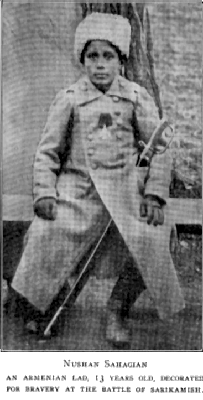
Picture - 13 year old Armenian volunteer earned a medal for his bravery
The relationship between the Armenians and the Ottoman Empire had already started to deteriorate after numerous massacres in eastern Anatolia during the 1890s. During July 1914 there were negotiations between the Committee of Union and Progress (CUP) and Armenian intelligentsia at the Armenian congress at Erzurum. The public conclusion of this congress was "ostensibly conducted to peaceful advance Armenian demands by legitimate means". The CUP regarded the congress as the seedbed for establishing insurrection. Historian Erikson concluded that after this meeting the CUP was convinced to pursue strong Armenian-Russian links with detailed plans to detach the region from the Ottoman Empire.
Martin Gilbert in The First World War states that in search of allies against the Turks, Nicholas II of Russia visited the "Caucasus front" on December 30, and told the head of the Armenian Church that "a most brilliant future awaits the Armenians". The head of the Armenian Church along with the president of the Armenian National Council in Tiflis Alexander Khatisyan received the Tsar, who said:
From all countries Armenians are hurrying to enter the ranks of the glorious Russian Army, with their blood to serve the victory of the Russian Army... Let the Russian flag wave freely over the Dardanelles and the Bosporus, Let your will the peoples remaining under the Turkish yoke receive freedom. Let the Armenian people of Turkey who have suffered for the faith of Christ received resurrection for a new free life.... -Nicholas II of Russia
As a result of the Tsar's speech, the Ottoman Empire saw their Armenian minority as a potential source of fifth column activity, treachery, and disloyalty, and did nothing to dampen anti-Armenian feeling among its populace. The Ottoman government claimed that it had a legitimate reason as a sovereign state to protect itself from an actual or projected Armenian uprising in favor of Russia or a Western Allied invasion of Ottoman territory. On his return to Constantinople, Enver blamed his failure on the actions of the region's local Armenians.
Repressive measures taken against the empire's Armenian population were an early stage of the Armenian Genocide.
Cultural references
Ballads (Turkish: AÄıtlar) was a book published in 1943 by YaÅar Kemal. It is a compilation of folk themes that include accounts of the Battle of Sarikamish.
Vetluga Memoir is a historical document that describes the political and strategic mistakes made by the Ottoman Third Army, and the final days of one corner of the Tzarist empire written by a young Turkish officer captured by the Russians.
120 is a 2008 Turkish film about 120 children who died carrying ammunition to the battle.
Bibliography
Tucker, Spencer (1998). The Great War, 1914-18. Indiana University Press. p. 272. ISBN 9780253211712.
Erickson, Edward J. (2001). Ordered to Die: A History of the Ottoman Army in the First World War. Greenwood Publishing Group. p. 256. ISBN 9780313315169.
Muratoff, Paul (1953). Caucasian Battlefields: A History of the Wars on the Turco-Caucasian Border 1828-1921. Cambridge University. p. 636. ISBN 0898392969.
Hinterhoff, Eugene (1984). The Campaign in Armenia. Marshall Cavendish Illustrated Encyclopedia of World War I, vol ii. New York: Marshall Cavendish Corporation. pp. 499-503. ISBN 0863071813.
Pasdermadjian, Garegin (1918). Why Armenia Should be Free: Armenia's Rx´le in the Present War. Hairenik Publishing Company. p. 45. http://books.google.com/books?id=u1MpAAAAYAAJ.
Pollard, A. F. (1920). A Short History of the Great War. London. p. 45. ISBN 1426422482. http://www.amazon.com/Short-History-Great-Large-Print/dp/1426422482.
Hacobian, Avetoon Pesak (1917). Armenia and the War: An Armenian's Point of View with an Appeal to Britain and the Coming Peace Conference. Hodder and Stoughton. p. 200. http://books.google.com/books?id=DcRGAAAAIAAJ.
More aircraft.
Source: WikiPedia